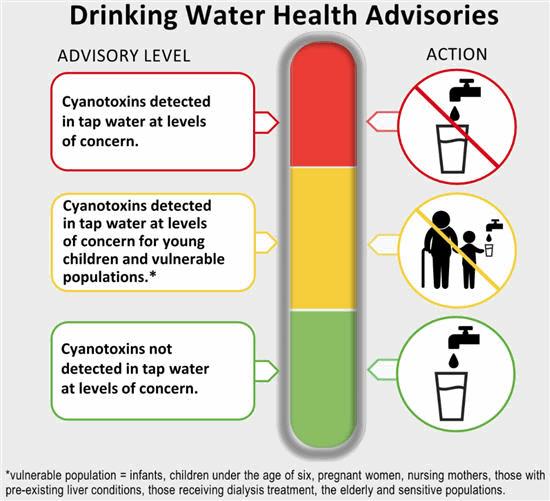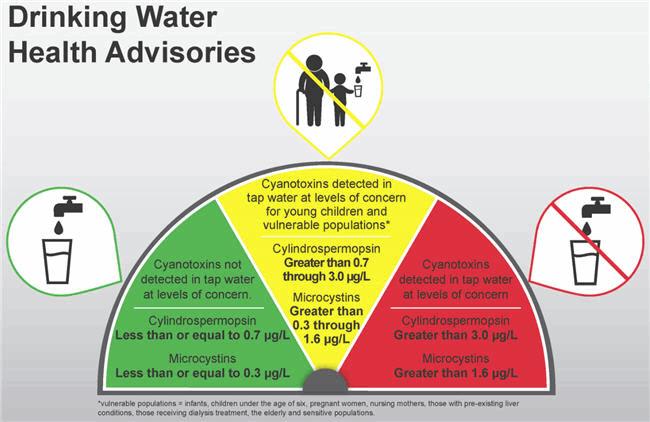EPA Speaks For Utilities On Cyanotoxins

By Kevin Westerling,
@KevinOnWater
The Drinking Water Cyanotoxin Risk Communication Toolbox takes the guesswork out of public outreach in the event of harmful algal blooms and cyanotoxin contamination.
There are few things that provoke more anxiety among drinking water utilities than a contamination event. The threat to the community is the primary concern, of course, but the prospect of communicating the incident to the public is nerve-racking as well. Operators are treatment experts, not public relations experts. That’s why the U.S. EPA has created a ready-made “communication toolbox” for cyanotoxin events, which occur due to surface-water algal blooms.
According to the EPA, climate change is exacerbating the problem, making it more likely that utilities will face the sort of challenge that forced a shutdown of Toledo’s water system in 2014. And speaking of exacerbating a problem, poor communication — whether too little, too late, or (in the worst cases) inaccurate — will worsen issues exponentially. Conversely, well-executed messaging will display competence and control over the situation, thus restoring consumer calm and confidence in the water authority.
Risk communication materials — and better yet, a communication plan — should be ‘at the ready’ for every utility, but the same tact will not be used for every situation. “Determining when to use these materials should be decided at the drinking water system level since each cyanotoxin event varies on a case-by-case basis,” the EPA advises. “Public water systems are encouraged to work with state and local officials to develop cyanotoxin management plans that, among other things, document the process for when and how to communicate with the public about cyanotoxins in drinking water.”
Once those ducks are in a row, the EPA has made the rest quite easy. Simply refer to this page to carry out the communications plan. It includes templates for traditional communications (press releases, drinking water advisories) as well as for text message alerts and social media postings.
For example, the EPA’s template for social media messaging via Twitter to broadcast a cyanotoxin drinking water advisory includes the following:
- “Drinking water advisory! Do Not Drink tap water in [location]. For more information see: [insert website link]”
- “Drinking water advisory! Residents in [location] should not drink their tap water. For more information visit: [insert website link]”
- “Drinking water advisory! Drinking water contains potentially harmful levels of cyanotoxins. Do Not Drink tap water in [location]. See: [insert website link]”
- “Resident in [location] should not drink their tap water. For more information visit: [insert website link]”
- “Residents should temporarily avoid drinking tap water in [location] until further notice. For more information visit: [insert website link]”
The EPA also provides graphics to include in various forms of communication. There are a number of messages available in three main styles: icon-based, thermometer/stoplight, and speedometer. An example of each is shown below.
![]()


Finally, the EPA provides Factsheets and FAQs about harmful algal blooms and cyanotoxins for general information purposes, soon to be available in Spanish as well.
The Drinking Water Cyanotoxin Risk Communication Toolbox was launched on November 3 alongside two related tools — the Cyanotoxins Management Plan Template (available with ‘Example Plans’ [PDF, 199 pages] or without [Word, 32 pages]) and Water Treatment Optimization for Cyanotoxins (PDF, 60 pages).
According to the EPA, the management plan template serves as "a framework for states, tribes, and public water systems to develop their own system-specific cyanotoxin management plans," while the optimization document "supports public water systems in developing monitoring and treatment optimization approaches for cyanotoxins to achieve the best performance possible from each treatment process."
It’s the behind-the-scenes efforts entailing preparation, prevention, and treatment — the complicated stuff — that is the bread and butter of the utility. But the front-and-center communications effort, though seemingly simpler, is where they could be in danger of fumbling. As drinking water utilities have plenty else to be concerned about, the EPA has done well to remove at least one cause of anxiety — the fear of public speaking.
Questions on the Cyanotoxin Risk Communication Toolbox should be directed to the EPA’s Katie Foreman at foreman.katherine@epa.gov or (202) 564-3403.
